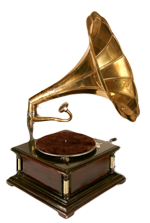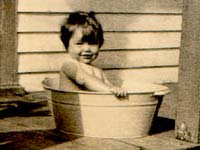![]()
Women were charged with creating and maintaining the family home. From the quilts that covered the beds to the potatoes that grew in the family garden plot, the women of the house orchestrated the daily workings of the domestic landscape by providing shelter, warmth and food.
The kitchen has been referred to as the "heart of the home" and it was the woman's principal duty to keep this vital organ in operation. During fishing season a woman might prepare four or five meals a day to cover the long working hours. She was adept at baking bread, making and preserving jam, and kept the cupboards stocked with important staples. Meal preparation was the principal task but cooking was the last step in a series of undertakings that included gardening, berry picking, ordering supplies, and making 'preserves'. But before any of these tasks could be accomplished, there was the issue of water to attend to.
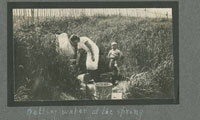
There are a number of archival photographs of women and girls carrying water buckets. The buckets are almost always attached to a hoop that hangs down from a board that is carried on the shoulders, allowing a wide enough berth for the woman to walk to the freshwater source, generally a stream, lake or well. They might make five or six trips a day, particularly if there was a load of washing to be done. Victoria Hayward, a journalist who visited and wrote about Newfoundland in the early 20th century writes:
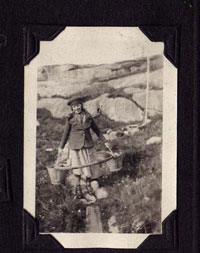
"The Outport well is usually situated at one end of the village and sometimes at a distance from it. And so, on Saturday afternoons, a stream of women, each carrying two buckets of water, flows along the undulating, rocky highway that is the village main street. A large hoop, in the midst of which the water-carrier steps, helps to relieve the weight and keep the water from spilling as the woman steps briskly along. This method of carrying water seems to be the Newfoundlander's own invention. The Water-Hoop is here one of the furnishings of every household."
Gardening was another vital task, providing an important source of nutrition. Women honed their growing skills and knowledge over generations. For instance, it was important to know that caplin worked best to fertilize potatoes while cod's heads with the stomachs attached worked best for turnips and cabbage. Hilda Chaulk Murray writes about her aunt's specialized fertilizer knowledge:
"Aunt Hilda told me that after the cod's heads were placed on the cabbage patch and rotted, the skeleton or bony part was taken off, and the soil underneath was shoveled around the cabbage roots. However, when cod's heads were put in a turnip patch, the skeleton was not removed."
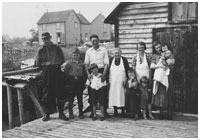
Gardening, water procurement, berry-picking and meal preparation were carried out in tandem with child rearing—women had many children, often spread over two decades. In some family photos the children range in age from toddlers to young adults.
However, as time progresses and children scatter, the family unit returns to its starting point—husband and wife, who in old age, rely on one another in as they had in the past.
